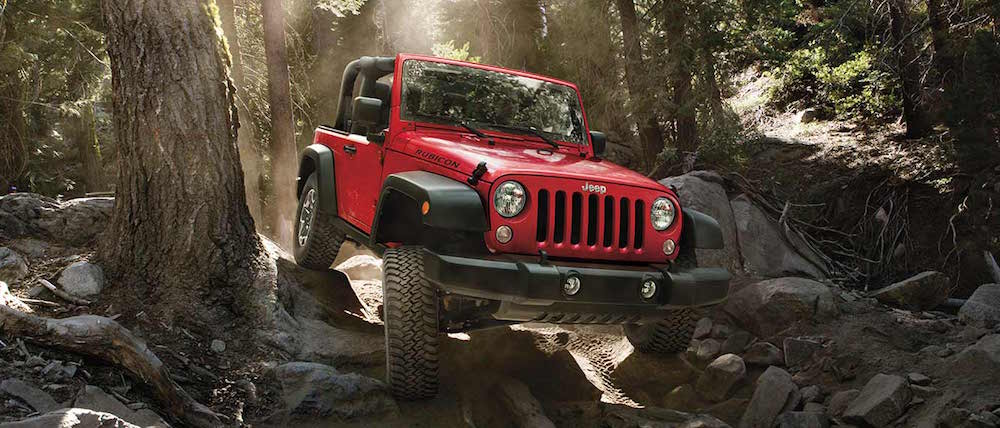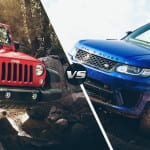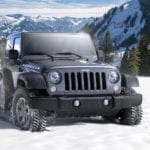Few vehicles have proven themselves as distinctive as the Jeep Wrangler has. Some might consider this a controversial (if not blasphemous) statement, especially if it diminishes their own personal preferences…but hear me out. A vehicle’s ability to set itself apart from less iconic offerings can be gauged by the intensity of its fan base; because a loyal consumer base means more than just sales. True enthusiasts, and the culture that they sustain, can become representative of the vehicles they love (in the same way people claim that dogs start to look like their owners). And if any vehicle has inspired such fanaticism, it’s the Wrangler. From ‘Jeep Life’ to the ‘Jeep Wave’, it’s hard to argue the immersive nature of Jeep ownership. So whether you’re shopping for something new, or exploring used Jeep Wranglers, get ready to fall down the rabbit hole.
But first, let’s get one thing straight. If you’re looking to buy used, especially if you’re looking to kick some mud up, you’re doing yourself a major service. With a change having taken place in the most recent model year offerings, a jump back over the last ten or twelve years offers you all the best of structural improvements – with your choice of which value-added features you feel are worth prioritizing.
With that in mind, let’s travel back to the late-nineties and learn more about the Wrangler during the years Jeep finally started to explore its true potential.
JK (We’re Not Kidding)
Despite the long and varied history of both the Jeep name and the Wrangler itself, the majority of used models to be found at dealerships and up for private sale, are likely to be either a 2nd-gen TJ or 3rd-gen JK series. Keeping in mind that the more recent JK have only been served up since the 2007 model year, you’re likely to encounter vehicles that are only about ten years old (or less). Anything older than that is likely to be a TJ, first introduced for the 1997 model year (unless of course, you’re buying some sort of vintage, hard-worn battlewagon from the most rugged of off-roaders). But no matter what, your decision to buy a used Jeep Wrangler proved wise, considering the fact that they retain their value surprisingly well. So let’s explore the JK lineup a little deeper…
In distinguishing the JK from that which came before it, it’s important to recognize its dimensional differences and the mindset behind them. Gaining 3.4-inches in width and 2-inches in terms of wheelbase, it actually measured 2.5-inches shorter in total length. This change enabled for a greater (44.3-degree) approach and (40.4-degree) departure angle, empowering off-roaders to tackle more aggressive terrain. This was further supported by the new option of a 32-inch factory tire, increasing the breaker angle from 22.6 to 25.4-inches without even considering an aftermarket lift or tire exchange.
Built upon a separate body and frame, the JK Series boasts rigid live axles in both the front and rear. As with its predecessors, it features a fold-flat windshield, and the option of removing the doors. And in addition to the basic two-door configuration, the JK Unlimited provides a longer wheelbase, four-door option able to accommodate more passengers.
But in addition to any dimensional changes, the Unlimited almost immediately served to highlight the changing role that technology and luxury-inspired features would play in the Wrangler’s evolution. From built-in navigation to satellite radio, it represented a change from the bare-bones (and often amenity-sparse) Wrangler of the past.
Originally, the JK Wrangler was served up in six trim levels (two-door) and four trim levels (Unlimited). Depending on the unique needs of the buyer, each trim offered a different take on the Jeep experience, with some more suitable for off-roading (or off-roading enhancements).
And therein lies the tandem motivation that would guide the JK through the decade to come. First, a desire to integrate technology in a manner reflective of changing consumer sensibilities and second, to continually improve the Wrangler’s versatility. Both would be visible during key model year updates, from the 2009 inclusion of (i) Hill Start Assist (ii) Trailer Sway Control and (iii) Electronic Stability Program to the 2011 inclusion of Bluetooth connectivity. Now celebrating the 70th anniversary of the Wrangler, Jeep would also begin to experiment with upgraded interiors and trend-conscious design philosophies. And it was within this time period, from 2012 to 2018, when the JK seemed to find its rhythm when incorporating its various new goals.
Bring Things (Almost) Current
As of last model year, the 2018 Jeep Wrangler had successfully integrated FCA’s various initiatives, merging the classic ruggedness of the Jeep with a long list of optional upgrades. Still the ideal platform for after-market mods, the newly-named JL stood as an enduring representation of all-things Jeep Life.
Despite various modificatons, the JL would retain its signature body-on-frame constructions as well as its solid axles. Offered up in three different 4WD systems, there is the option of Command-Trac, Selec-Trac or Rock-Trac modes allowing the JL to be the most versatile Wrangler to date.
Available in two-door or four, rear-wheel drive or 4×4, the Wrangler now came powered by a 3.6-liter Pentastar V6 paired to 6-speed manual transmission. There were also the options of incorporating a 2.0-liter I4 Turbo eTorque Engine and/or an 8-speed automatic transmission. Of the engine configurations, the former could serve up 285 hp and 260 lb-ft of torque, while the latter was capable of churning out 270 hp and 295 lb-ft of torque.
Averaging 25 highway mpg and 17 city, the Wrangler would never prove to be the most frugal in terms of fuel economy, but that’s not really the point (is it). Even with the announcement that 2019 would introduce a 3.0-liter EcoDiesel V6 Turbodiesel option (delivering 260 hp and 442 lb-ft of torque) with a plug-in hybrid variant to follow in 2020, it simply makes the Wrangler more palatable to a wider audience. As far the core enthusiast goes, it’s about the overall experience – not the minutiae.
With the ability (when properly equipped) to tow up to 3,500 LBS while offering the most idyllic open-air experience available, the ambitious JL has evolved to a point where it offers something for everyone. In fact, the niche appeal of Wranglers-past is all but diminished thanks to the FCA’s determination to evolve the off-roader into a rugged, yet stylish, tech-centric confirmation that you really can have it all.
Wrapping Things Up
Perhaps you’ve long embraced and embodied the ways of Jeep Life but then again, maybe you’re popping the proverbial cherry with your decision and shopping around for used Jeep Wranglers. Either way, Jeep culture goes largely unchallenged in terms of scope, so there’s plenty of room for everyone. From rock-crawlers to mall-crawlers, there’s something out there for everyone and unique displays of brand passion welcoming to new participants. Just know what you want, find the right community (or make your way alone) and have some fun with it. After all, as Jeep so eloquently phrased it: today was made for adventure.




